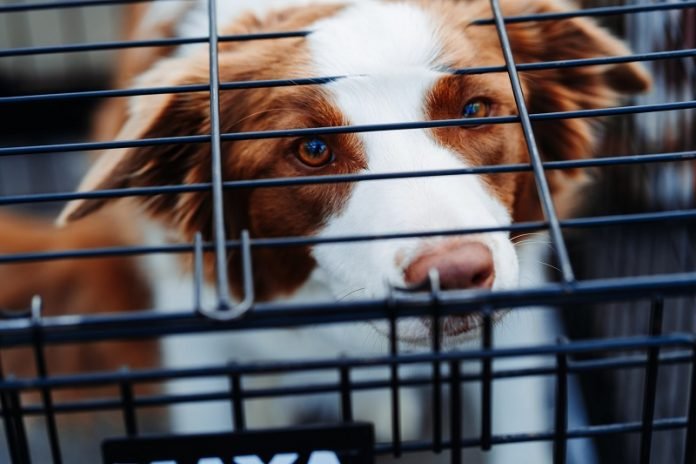
Federal authorities are moving 4,000 beagles from a breeding and research facility in Virginia after it was discovered that many of them were neglected or in ill health, The New York Times reports.
The news, which broke last week, piqued the interest of dog lovers across the country, some of whom volunteered to adopt one or more of the rescued animals.
It also prompted questions about how often dogs are used in animal testing, and what institutional failures led to 4,000 beagles living in such poor conditions.
Clinical research using dogs is much more common than you’d think, says John Basl, an associate professor of philosophy at Northeastern, though laws are in place to help prevent unnecessary suffering.
But even when these regulations are followed, there remains a moral dilemma over whether animals should be used in this way, and whether dogs should be treated differently.
The U.S. Department of Agriculture report on the Envigo breeding and research facility in Cumberland, Virginia revealed appalling mistreatment and blatant disregard for animal welfare. Among their findings, officials reported that injured beagles were being euthanized instead of treated, and many were neglected and in ill health, The New York Times reports.
Now, the 4,000 beagles are up for adoption.
They form just a fraction of the number of dogs that are bred and used for research purposes in the United States. Dogs are “a controversial but widely used animal for animal experimentation,” Basl says.
According to the U.S. Department of Agriculture, 58,511 dogs were used in USDA-registered research in 2019, and 16,013 of those dogs likely experienced pain as part of the research.
Among the dogs that are used for animal testing, beagles are preferred because they are small and docile.
In addition, Basl says, if previous research has been done on beagles, a new, similar study will likely use them as well. “One reason to choose a particular species is because we have a history of data on that species and so we can ensure new data is commensurate with old data,” he says.
Still, the number of beagles used in animal research pales in comparison to the number of rodents in labs.
Mice and rats are by far the most commonly used lab animal—one disputed study found that over 100 million mice and rats are being used in clinical testing, and that they comprise over 99% of lab animals—but according to Basl, all clinical trials must be done on more than one animal, and one of the animals cannot be a rodent. Bunnies are not rodents, so they are used for this purpose, as are dogs, cats and non-human primates.
For these animals to come from a breeding facility like the one in Virginia is not a surprise, Basl says. Sometimes, institutions that perform animal testing will breed their own animals. “But oftentimes, that work is outsourced,” he says.
Laws regulating treatment of these animals have been in place for over half a century. In 1965, U.S. Rep. Joseph Resnick introduced the Laboratory Animal Welfare bill, a precursor to the Animal Welfare Act (Resnick’s bill was in response to reports that family dogs were being stolen and used for animal testing).
In 1966, the Animal Welfare Act passed, becoming “the only Federal law in the United States that regulates the treatment of animals in research, teaching, testing, exhibition, transport, and by dealers,” according to the USDA, one of the agencies charged with enforcing the law.
In 1985, an amendment to the AWA added another layer of protection for lab animals. According to the Animal Legal Defense Fund, any institution—including universities like Northeastern—that experiments on animals must establish an institutional animal care and use committee, which must include a veterinarian and someone outside the institution, to regulate animal testing. According to Basl, for a researcher to use an animal for testing, they must justify the need to use animals to the IACUC, and to adhere to guidelines.
This precludes researchers from harming animals unless it is required to achieve research ends, he says, and also requires them to house social animals together unless the experiment specifically requires them to be isolated.
However, “there are IACUCs that are not doing their job,” Basl says. In the Virginia case, conditions at Envigo prompted lawmakers to introduce five “beagle bills” addressing animal welfare and to put pressure on the USDA to investigate AWA violations at the facility. The facility will close and all of the dogs are being removed.
Even if the laws had been followed, should the dogs have been there in the first place? This is one of the moral quandaries Basl contends within his research.
For Basl, a huge factor when considering the relative morality of animal testing is their mental capacity, which determines “the extent to which you can harm a being,” he says. Rabbits, for example, typically have a more narrow range of mental capacity than humans; they cannot reflect on past traumas, and do not have the capacity to think far into the past or into the future.
“That can be the source of both great enjoyment but also significant suffering,” he says. Moreover, “different species vary with respect to that capacity, and we don’t always know how much, and often as humans we underestimate the capacities of animals.”
Mental capacity is the main reason for how rare chimpanzees are in animal testing, Basl says. “Because of the capacities that chimps have, because they’re so much like us, it’s much harder to justify their use, so they’re used less frequently,” he says.
Cultural factors may also influence what is considered acceptable when it comes to testing. The value placed on dogs in the United States, for example, makes it less palatable to test on them as opposed to rodents. At the same time, our relationship with dogs may actually mean they suffer more than other lab animals.
“Domestication has changed the profile of their capacities,” Basl says. Dogs are especially sociable and capable of having relationships with humans that differ from many other animals, he says, and this can make them susceptible to different forms of suffering.
Despite the relative nature of suffering between species, Basl says, “Most mammals suffer from the kinds of things done to them that would harm us,” and he tends to think of mammals as roughly equally capable of suffering.
This suffering can be harder to justify knowing that the success rate of clinical trials on animals is quite low: Basl says only a small fraction of clinical trials using animals yield drugs that are of benefit to humans.
“Most animal studies do not yield direct benefits,” Basl says. However, the law dictates that clinical trials must be done on animals before moving to humans, and, for drugs that do make it through trials, “the payoff can be huge, though whether the same benefits could be realized without animal testing and while avoiding harms to humans remains an open question.”
Written by Jessica Taylor Price.



